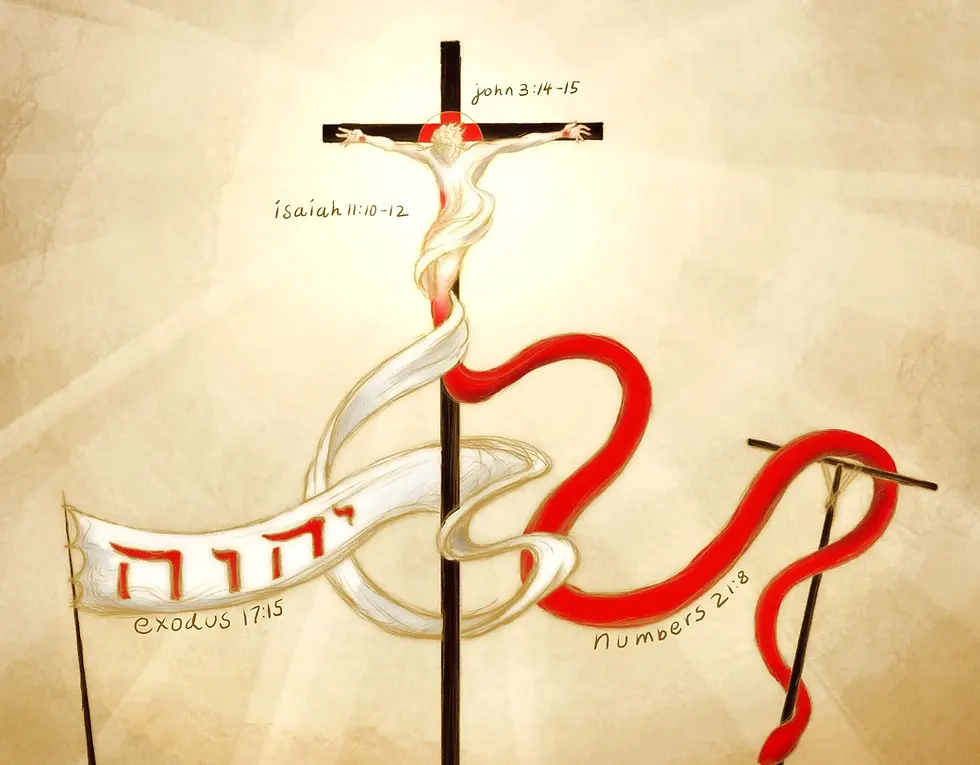GAZING AT THE CRUCIFIED ONE
- Charles
- 13 sept. 2025
- 3 min de lecture
Reflections on the Feast of the Exaltation of the Holy Cross: Numbers 21:4b-9, Philippians 2:6-11, John 3:13-17

The liturgy invites us to turn our eyes to the Crucified One. For here, upon the wood of Golgotha, lifted high like the serpent in the wilderness (first reading), resides the paradoxical summit of divine revelation and the profoundest icon of our salvation. To know Love Incarnate, to fathom the abyss of mercy and the call to discipleship, we must dare this contemplation: to gaze upon the lifted Christ. And this contemplation, offered to us this Sunday on the Feast of the Exaltation of the Holy Cross, occurs through the mediation of a very particular icon: the figure of the serpent. “Just as Moses lifted the serpent up in the wilderness, so must the Son of Man be lifted up”.
An icon, not an idol. French philosopher Jean-Luc Marion clarifies the difference: An idol reflects upon oneself. It points to nothing beyond itself. The icon, on the other hand, challenges us to elevate our gaze beyond the icon. The gaze must ascend from the visible to the invisible, from the evident to the mystery. To gaze upon the cross, upon the serpent, is to lift our gaze, raise our eyes, broaden our vision, and access an awareness of what is at stake.
Upon the cross, we gaze at a victim. Isaiah describes him as “a man of suffering... despised and rejected... as one from whom others hide their faces... he had no form or majesty that we should look at him, nothing in his appearance that we should desire him” (53:2-3). While classical myths and contemporary films glorify the victor, the Gospel compels us to look upon the victims, those on the existential, social, cultural, and geographical periphery: the little ones, the poor, the lost sheep. But let us go further.
On the cross, we also recognise something of ourselves. Jesus on the cross is the image of evil, of “our” evil, for it was human sin that put him to death. At the school of the exalted Cross, we contemplate our own fallen nature. The Crucified One is “pierced for our transgressions”. He bears the weight of our rejections, our idols, and our abuses. On the Cross, Jesus becomes the serpent, and by turning our gaze towards him, it is this evil that we agree to look upon. To be healed, we must agree not to close our eyes, to face the evil, “our” evil.
The Cross, which is the summit of evil, also becomes the guarantee of healing and salvation. Jesus defeats the enemy “by becoming sin”, “by becoming the serpent”. For John, the crucifixion of Jesus is both torture and exaltation. The Crucified One becomes the universal focal point. The cross “lifts us all up”? This is why the crucifix is not a piece of jewellery.
It is the mystery of annihilation, of the kenosis sung by Paul, in the second reading: Christ Jesus, though he was in the form of God... emptied himself... humbled himself... obedient to the point of death on a cross”. The God-Father, revealed on the cross, is a fragile, vulnerable, and disarmed God. He is a God who cannot impose Himself, for love cannot be imposed or bought. On the contrary, He is a God who exposed Himself to human rejection, who eternally awaits our consent without ever tiring.
The spectacle of the Crucified One creates a separation: those who accept to look and those who turn away. When we hear about the “final judgment”, let us not forget that judgment does not come from outside; it is man who judges and condemns himself when he refuses to believe. Condemnation is not an external act; it is an interior act. It is the act of one who refuses the love of God manifested by the gift of the only Son on the Cross.
The Son of Man was not sent to judge but to save. It is men who judge: “They preferred darkness to light”, says the Gospel. To prefer, to choose, to decide: here lies our judgement. Amidst the serpents crawling at our feet, the icon of Christ, nailed to a pole, offers us a change of perspective, a displacement of our existence, a horizon of life. To gaze upon the Crucified is to open our lives to the love of God, offered, voluntarily, and perpetually on the cross. For where the Cross is exalted, there we find the traces of a better word, the inexhaustible wellspring of grace, and the luminous path to eternal life. Let us lift our gazes and live.




Commentaires